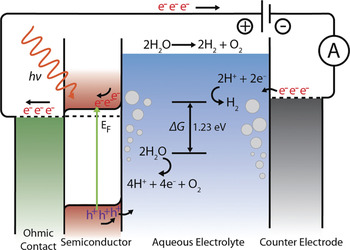Efforts to develop technologies for solar water splitting based on inexpensive, earth-abundant materials date back to the 1970s. Efficiencies of developed systems, however, remain low. One source of this inefficiency is the mismatch between the length scales of the key events; photon absorption occurs up to a few microns, while electron-carrier extraction is limited to several tens of nanometers. Photoexcited carriers are therefore generated too far from a reactive surface, and recombine before they can be converted to fuel. One general approach used to overcome this problem is the design of structured materials where the photon propagation and charge-transport directions are orthogonal to each other. Recently, I. Thomann and B.A. Pinaud from Stanford University and their colleagues showed that plasmonic resonances from metallic nanospheres can be combined with multilayer interference effects to better manage photons for more efficient solar conversion.
Collective electron oscillations in metallic nanoparticles are termed surface plasmons, and their resonance frequencies can be tuned from UV to near IR by changing the nanoparticle size, shape, and dielectric environment. As reported in the August 10 issue of Nano Letters (DOI: 10.1021/nl201908s; p. 3440), the research team employed the existing knowledge-base of plasmon-enhanced photovoltaics to demonstrate that plasmonics can enhance solar energy conversion to fuels. The researchers used a typical solar cell comprising an iron-oxide (α-Fe2O3) photoelectrode to measure wavelength-dependent photocurrents and therefore to determine the photocurrent spectra. The efficiency of this system was then improved through the introduction of metallic nanoparticles to alleviate poor charge transport and concentrate incident sunlight close to the semiconductor–liquid interface (see figure).

This schematic of the band diagram shows the semiconducting electrode absorbing sunlight while in contact with an aqueous electrolyte solution in which photogenerated holes cause O2 and electrons to be generated. The electrons are transported to a counter electrode where they react to produce H2 and close the circuit. The researchers used α-Fe2O3 together with metallic nanoparticles as the semiconducting electrode, and measured the photogenerated current as a function of illumination wavelength. Reproduced with permission from Nano Lett. (DOI: 10.1021/nl201908s; p. 3440). © 2011 American Chemical Society.
First, 50-nm Au nanoparticles with a thin, nonreactive silica shell were either covered with a 100-nm thick iron-oxide film or deposited on top of a 90-nm thick iron-oxide film. When nanoparticles were located on the bottom and on the top of the film, strong photo enhancements were observed for wavelengths longer than 550 nm. The strongest resonance peak enhancement was obtained at 610 nm and 590 nm, with enhancements of 11 and 20 times, respectively, over the photocurrents observed for films without nanoparticles.
In order to investigate a more nearly ideal optical system, the researchers repeated the experiments and simulations with uncoated Au nanoparticles. While a symmetrical photo enhancement as a function of wavelength was observed when the nanoparticles were located at the bottom of the iron-oxide film, an asymmetric photo enhancement was found when the nanoparticles were on top of the film. This difference was attributed to interference between the incident light wave and the scattered fields from the nanoparticles.
The researchers said, “We anticipate that the concepts described here will also be highly relevant to the development of future, more effcient, multi-junction photoelectrochemical cells, where sunlight is split into multiple spectral components, each of which requires its own optical tailoring and enhancement strategies.”


